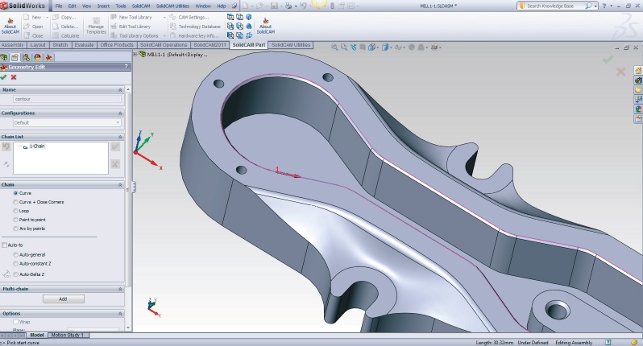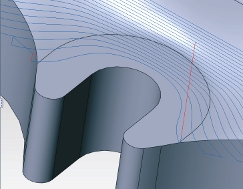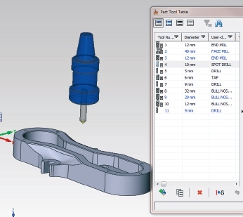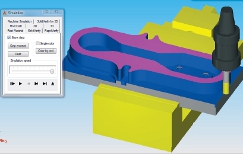With today’s trend towards outsourced manufacturing, it may come as a surprise that many design and engineering houses are looking to bring their machining operations back in house. Or indeed, to establish them for the first time.

SolidCAM is integrated directly into the SolidWorks users interface, so geometry manipulation and selection will immediately be familiar to any users
Many are quoting a level of frustration and lack of control over outsourced operations, while others see producing locally as much more sensible. Alongside this, economic downturns often have the effect of spurring on displaced staff from larger companies setting up on their own and that’s no less true than in manufacturing. So, we have a situation where machine tools are being installed into new environments.
While it’s perfectly possible to program these machines manually, a much more appropriate method is to use a CAM (or Computer Aided Machining or Manufacturing) system. This lets you work off your 3D CAD geometry and create toolpaths that should be efficient and much less error prone than doing it manually.
The problem is often that the CAM system costs can greatly add to the capital costs when buying machine tools. With this in mind, the team at SolidCAM has introduced SolidCAM Xpress, which brings the basic functionality from its full blown product to market at a much lower cost.
So let’s explore what you can actually do with it.
Benefits of CAD integration
SolidCAM is built directly into SolidWorks’s user interface. While there’s the usual pulldown menu addition, the majority of functions are driven from the SolidCAM PropertyManager and machining tree structure that stores all of the set-up and operations.
Just as with the full product, all the modelling and editing operations that are part of the SolidWorks toolkit are at your disposal. A perfect example is the set-up for a machining job. SolidCAM uses assemblies as the basis for part programming. That gives a couple of advantages. Firstly, because the part being machined is disconnected from the originating part file, the user has the ability to adjust its orientation and set-up the datums for machining without having to adjust the native part. It also means that part geometry for fi xtures can be brought in so they can be avoided where required.
Once the datum is set-up and any fixtures are in place, the part programming process can begin. First task is to define the stock for the part. This can range from a basic billet size (which can be auto-sized), use a configuration of a part (for those parts with machining stock added) or you can even import an STL file for castings and forgings.
As we’ve already discussed, SolidCAM Xpress is a reduced functionality version of the full system. The system is supplied with basic 2D machining operations that can handle face and pocket machining, profiling and drilling. It’s also worth noting that the team at SolidCAM has chosen to provide a basic 3D surface machining operation into the Xpress version too. The rationale is that it’s very easy to define 3D surfaces within your CAD system, so they’re giving you the chance to machine those forms in this lower-cost product.
The process for defining an operation is pretty simple. Taking the example of creating a pocketing operation, you select the geometry for the boundary (and the depth), add the operation from the menu
and define the parameters. SolidCAM Xpress shares the same cutter database with the full system, so you have the ability to select from a pre-defined list of cutters either per machine or across your
machine shop.
As you’d imagine, feeds and speeds are derived from the cutter and the material and the depth is typically derived from the geometry. A point worth noting is that the system flags up whether the parameters are automatically stripped from your geometry (flagged with a red colour) or if you’ve overridden them. The system also gives support for all the usual high-speed machining aspects such as entry and exit options. Once done, the system allows you to simulate the material removal as a sanity check before you commit.
The other operations follow a similar process. Drilling will allow you to either pick up the hole definition from the SolidWorks model (assuming you’ve defined it using the intelligent hole wizard tool) or allows you to define a number of cycles to create the holes you need, in the manner you want.
One thing worth discussing a little more is the surface machining operation. This gives you two operations, either a constant-Z or waterline or a parallel or zig-zag strategy. It’s pretty basic, but the ability to machine these more complex forms, at a low cost, is very handy indeed.
Once your list of operations is complete, you can generate the g-code. Again, the system includes all of the post tools from the full blown product. It’ll also output setup sheets with all the datum locations, tool set-ups for use on the shop-floor.
In conclusion
The machining world is changing. Machine tools are dropping in price and there’s also this vaguely counter intuitive trend towards new machine tool adoption. As a result, having a CAD integrated CAM system that’s low cost makes perfect sense to me.
While I’m sure the die hard machinist will scoff at the reduced set of functionality, that would be missing the point entirely. There’s a whole raft of users and organisations that are carrying out machining for the first time that simply don’t need those advanced tools.
That might be a start-up producing components for the first time. It might also be a team running a smaller scale machine tool in a prototyping workshop. It’s these users that can derive huge benefit from using CAD integrated CAM, but typically can’t afford it or justify the considerable costs.
solidcamxpress.co.uk
| Product | SolidCAM Xpress |
|---|---|
| Company name | SolidCAM |
| Price | £995 |









